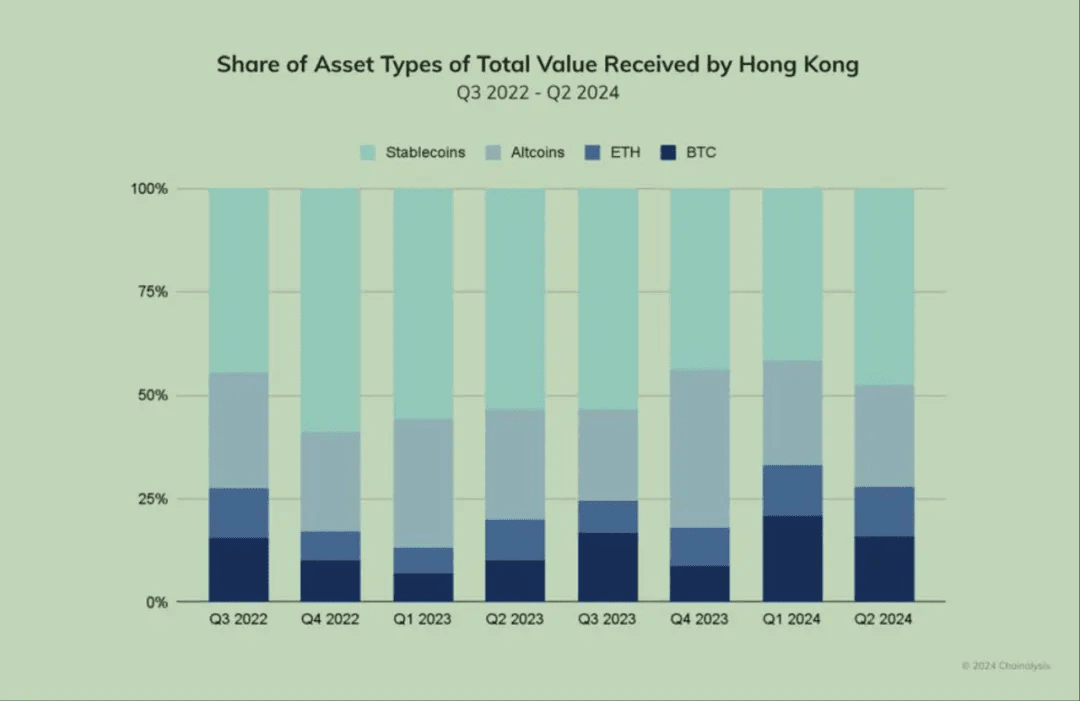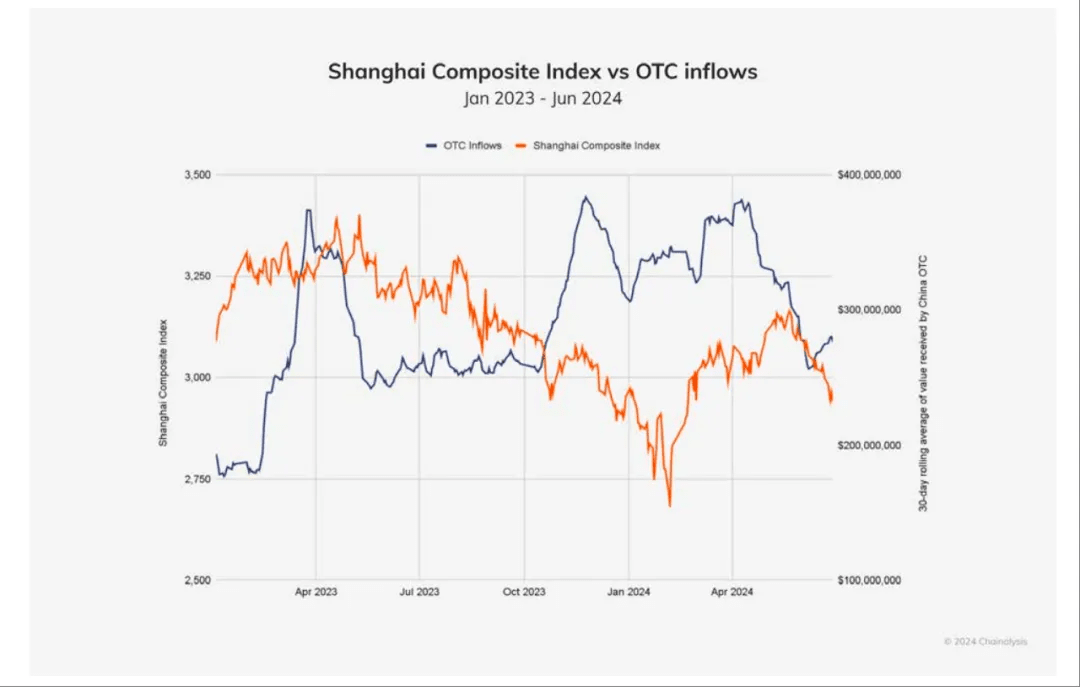In recent months, stablecoins have undoubtedly become the hottest topic in the financial and crypto circles! The US and Hong Kong have successively passed legislation supporting stablecoins, and internet giants and established financial institutions are getting involved, either hoarding coins or applying for licenses, as if spring has suddenly arrived overnight, with a profusion of blossoming pear trees. In contrast, mainland China still appears to be sitting firmly on the sidelines, with no signs of policy loosening. Among this, a piece of news about the large-scale use of stablecoins in Yiwu has spread widely online, mainly citing two sources: the Huatai Securities research report shows that stablecoins have become an important tool for cross-border payments in Yiwu, and blockchain analysis firm Chainalysis estimates that the on-chain stablecoin flow in the Yiwu market will exceed 10 billion USD in 2023.
Interestingly, when reporters conducted on-site visits and surveys, most merchants indicated they had not heard of stablecoins and were unaware of them. A small number of merchants expressed doubts about the compliance and costs of stablecoins, with only a few merchants clearly stating they had used stablecoins for payments. The scene felt somewhat like the elderly downstairs responding to Charlotte's 'What’s that horse name?' and 'What’s that Dong name?' mystery. What is the real situation? Let's dig into the two sources of information.
Huatai Securities Research Report
Based on publicly available information, I was unable to find a specific name and source attached to this research report from Huatai Securities in the media. However, with the help of friends, I found a macro securities research report published by Huatai Securities on June 25, titled (How Will Stablecoins Affect the Global Monetary System?). This 31-page report systematically elaborates on the development prospects and risks of stablecoins globally across eight chapters. On page 8 of the report, there is a statement regarding the use scenarios of stablecoins:
Apart from being used directly for transactions involving crypto assets, the proportion of stablecoins in global trade of goods and services, their role as a means of storing value, and the penetration rate among residents are all rapidly developing. Specifically, in Yiwu, the world's small commodities center, stablecoins have become an important tool for cross-border payments. Blockchain analysis firm Chainalysis estimates that the on-chain stablecoin flow in the Yiwu market will exceed 10 billion USD in 2023.
However, unlike other viewpoints in the report supported by data and charts, this viewpoint does not have accompanying data support.
Overall, the report remains quite readable. Below are some selected viewpoints from me:
1. Countries represented by the United States (dollar hegemony), the European Union (single market), and China (potential market) with large monetary volumes and stronger legislative demands have a huge market size for stablecoins; countries represented by South Korea, which have developed digital and virtual economies, and countries represented by Singapore, which are highly open and reliant on external trade, will have high penetration rates for stablecoins; emerging market economies such as Turkey, Argentina, and Nigeria, characterized by low currency stability, underdeveloped banking systems, large underground economies, restricted capital flows, or even sanctions, will also see high penetration rates for stablecoins.
2. In response to the challenges posed by the development of stablecoins, major economies typically adopt two strategies: issuing digital currencies or strengthening regulation of stablecoins. For mainland China, research on digital currencies began as early as 2014 and a pilot program was launched in 2019. With the rapid development of stablecoins, especially the stablecoin legislation in Hong Kong set to take effect this August, this may mark China's shift to a 'dual-track' development path. On June 18 this year, the head of the central bank clearly stated at the Lujiazui Forum that emerging technologies such as blockchain and distributed ledger technology are driving the vigorous development of central bank digital technology and stablecoins, indicating a significant increase in the importance attached by the People's Bank of China to stablecoins.
3. Hong Kong's stablecoin legislation is expected to accelerate the development of the Hong Kong dollar, offshore renminbi, and even renminbi stablecoins, providing impetus for further appreciation of the renminbi. Expanding the 'fund pool' of the Hong Kong dollar and offshore renminbi, enriching the high liquidity assets that can be invested in such as interest rate bonds, vigorously developing cross-border business, digital economy, and virtual economy, and increasing stablecoin usage scenarios are key to the success of Hong Kong's stablecoins, which will also reactivate the process of renminbi internationalization.
4. Stablecoins pose challenges to cross-border financial regulation while facing certain levels of redemption risk. When the value of reserve assets fluctuates, the issuer's credit is challenged, or even if the issuer goes bankrupt, fiat stablecoins may also experience a decoupling of value. As the scale of stablecoins expands and their impact on the traditional financial system deepens, it may ultimately require accepting stricter regulation, and even partial nationalization, in exchange for true stability.
Data analysis from Chainalysis
Unfortunately, through searching internal and external networks and reviewing the 2023 and 2024 (Cryptocurrency Geographical Reports) released by Chainalysis, I found no relevant statements or data supporting the use of stablecoins by Yiwu merchants.
I have also selected data and viewpoints regarding mainland China and Hong Kong from the two reports by Chainalysis: For a long time, the proportion of the value of crypto assets received by users in Hong Kong has remained above 40%. With the stablecoin legislation in Hong Kong set to officially take effect this August, this proportion is expected to rise further.

Figure 1: High proportion of stablecoins among the crypto assets received in Hong Kong - Chainalysis
Data shows that Chinese users utilize crypto assets to achieve the preservation and appreciation of wealth.

Figure 2: Comparison of the Shanghai Composite Index and OTC inflow from January 2023 to June 2024 - Chainalysis
In my opinion, while there may be a lack of accurate data to verify whether stablecoins are being used on a large scale in Yiwu, the combination of foreign trade and stablecoins indeed has inherent advantages. The characteristics of stablecoin payments, such as instant settlement, stable value, and low fees, address many pain points for small and medium-sized foreign trade merchants.
However, on the other hand, considering the regulatory policies of mainland China regarding stablecoins and other crypto-assets, there are serious compliance issues if mainland foreign trade merchants directly use stablecoins during transactions, and there is even a possibility of criminal risks.
Furthermore, considering that the implementation of the current export tax rebate policy in China often requires providing bank settlement slips, using stablecoins would mean being unable to provide this certificate, thus missing out on export tax rebates, which would be fatal to merchants' profits. On the other hand, the qualification for participation in trade fairs such as the Canton Fair usually considers the bank transaction records of exporting companies as an important reference standard, and the lending review standards of commercial banks also emphasize the bank transaction records of exporting companies. These factors determine that, for now, the usage scale of stablecoins among Yiwu exporters will not be very large.
So, how can mainland foreign trade merchants compliantly utilize stablecoins to reduce costs and increase efficiency? Currently, a relatively compliant way is to link a Hong Kong company with a mainland company, utilizing Hong Kong's external trade convenience and open policies towards crypto assets to achieve compliant integration of traditional foreign trade and crypto payments.
Hong Kong dollar stablecoin and feasible compliance models for using stablecoins in foreign trade
On August 1, the Hong Kong (Stablecoin Ordinance) will officially take effect, and the Hong Kong government will also begin processing license applications for issuing stablecoins in Hong Kong. This means that stablecoins recognized by the Hong Kong authorities will officially go live, and the exchange between Hong Kong dollar stablecoins and fiat currencies will become more convenient and compliant.
1. The 100% redemption requirement for Hong Kong dollar stablecoins
The Hong Kong (Stablecoin Ordinance) stipulates that stablecoin issuers must ensure that their issued stablecoins have sufficient reserve assets to support them, ensuring that the market value of the reserve assets is not less than the par value of the issued stablecoins in circulation.
Stablecoin issuers should ensure that holders of stablecoins have the right to redeem them and must not obstruct or restrict the redemption of stablecoins. No fees other than reasonable transaction fees should be charged at the time of stablecoin redemption.
2. The Hong Kong dollar stablecoin meets compliance requirements for anti-money laundering, anti-terrorist financing, etc.
The Hong Kong (Stablecoin Ordinance) states that issuers of the Hong Kong dollar stablecoin must adhere to strict anti-money laundering and anti-terrorist financing requirements.
In a consultation document released by the Hong Kong Monetary Authority on May 26, the authority outlined the relevant anti-money laundering and anti-terrorist financing requirements, which include key requirements such as:
Customer due diligence. For transactions of purchase or redemption that meet or exceed the benchmark of 8,000 HKD, customers must undergo due diligence, including verifying wallet ownership;
Strict regulation of non-custodial wallets. Implement strict monitoring and transaction limits on non-custodial wallet transactions to reduce the risk of misuse by illegal actors;
Ongoing monitoring. Use blockchain analysis to track transaction history and detect illegal activities, and report suspicious transaction activities;
Due diligence on custodial wallet providers;
Blacklisting illegal wallet addresses.
3. Key points for mainland foreign trade merchants to compliantly utilize Hong Kong dollar stablecoins
Considering the current policy differences between mainland China and Hong Kong regarding stablecoins, I believe that mainland foreign trade merchants can avoid most compliance risks by grasping the following three key points when utilizing Hong Kong dollar stablecoins:
Utilize Hong Kong or other overseas company entities to receive and pay stablecoins;
Complete compliant exchange of stablecoins with fiat currencies in Hong Kong;
Compliant conversion of fiat currencies back to the mainland parent company.


